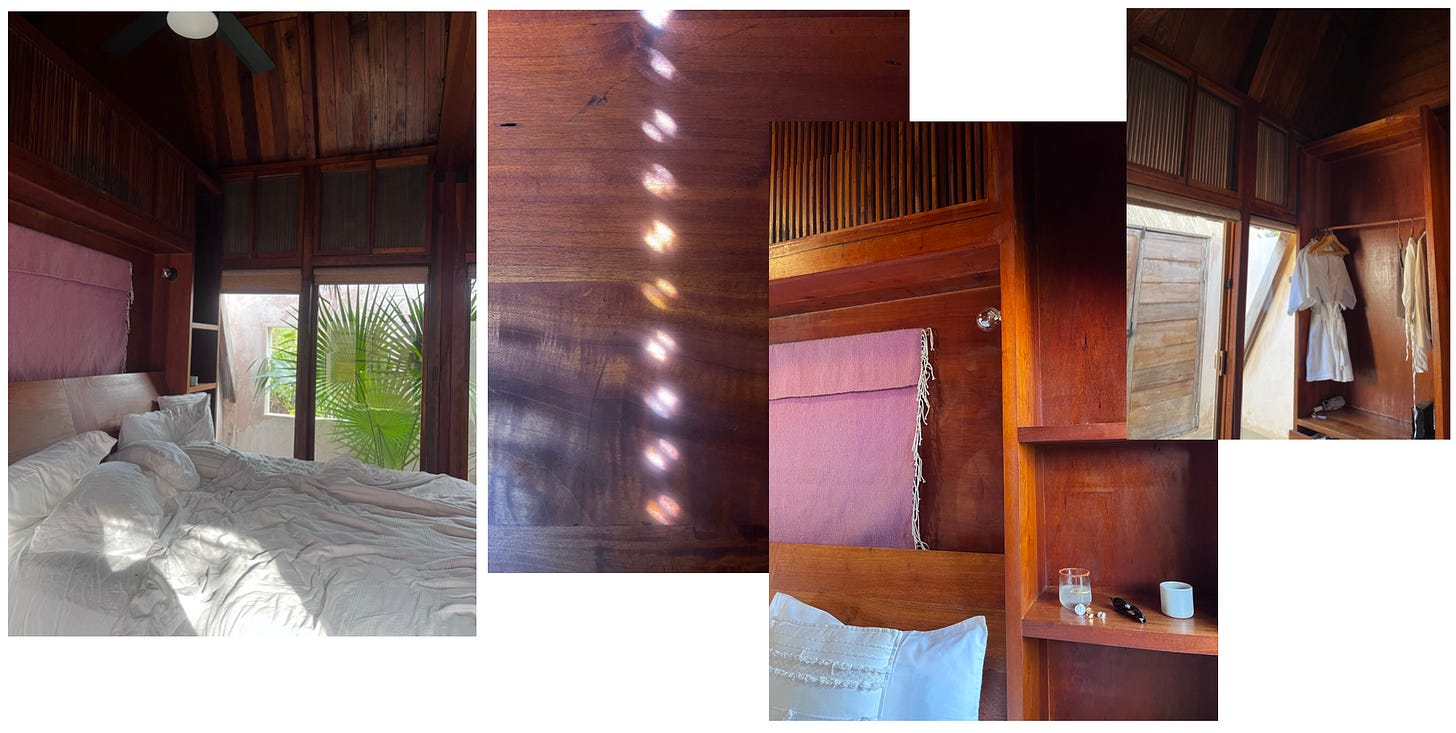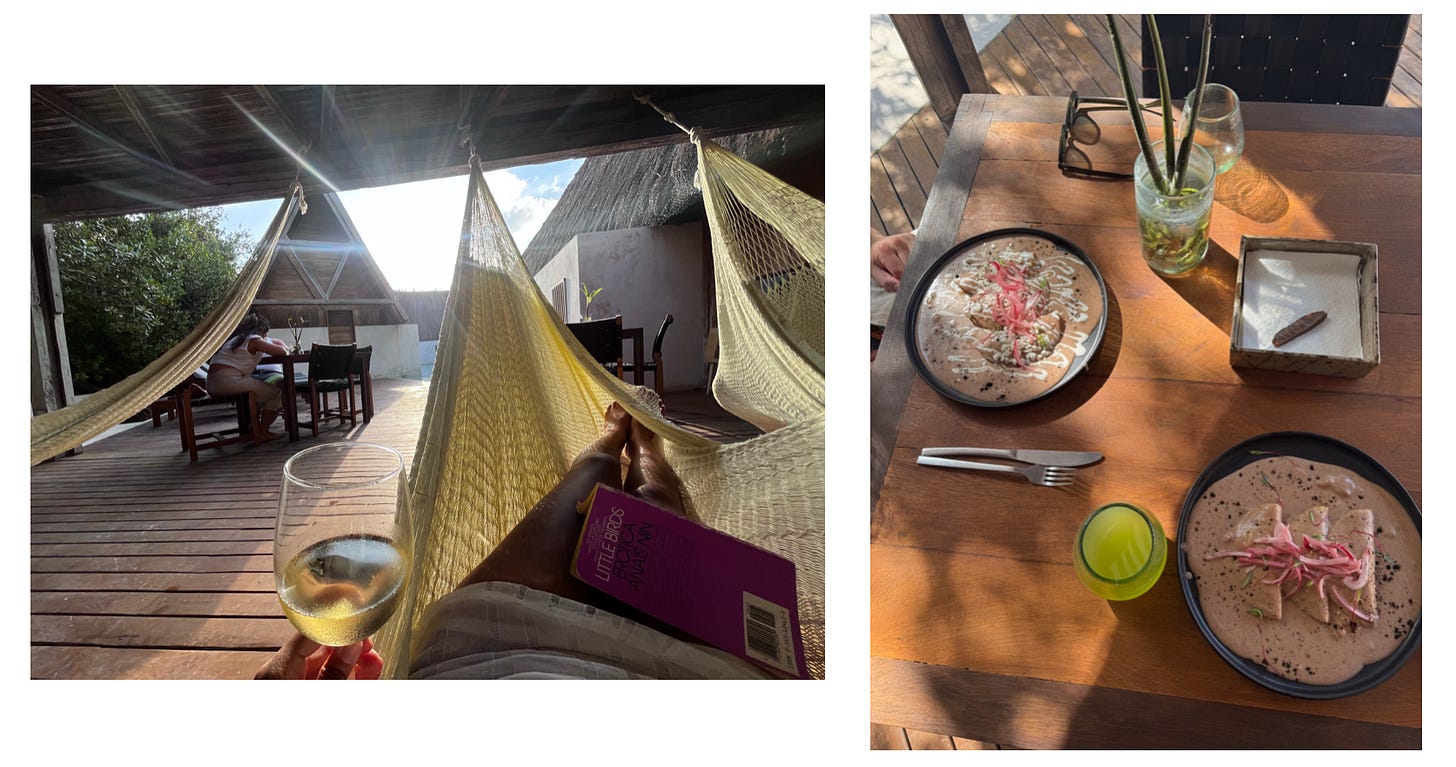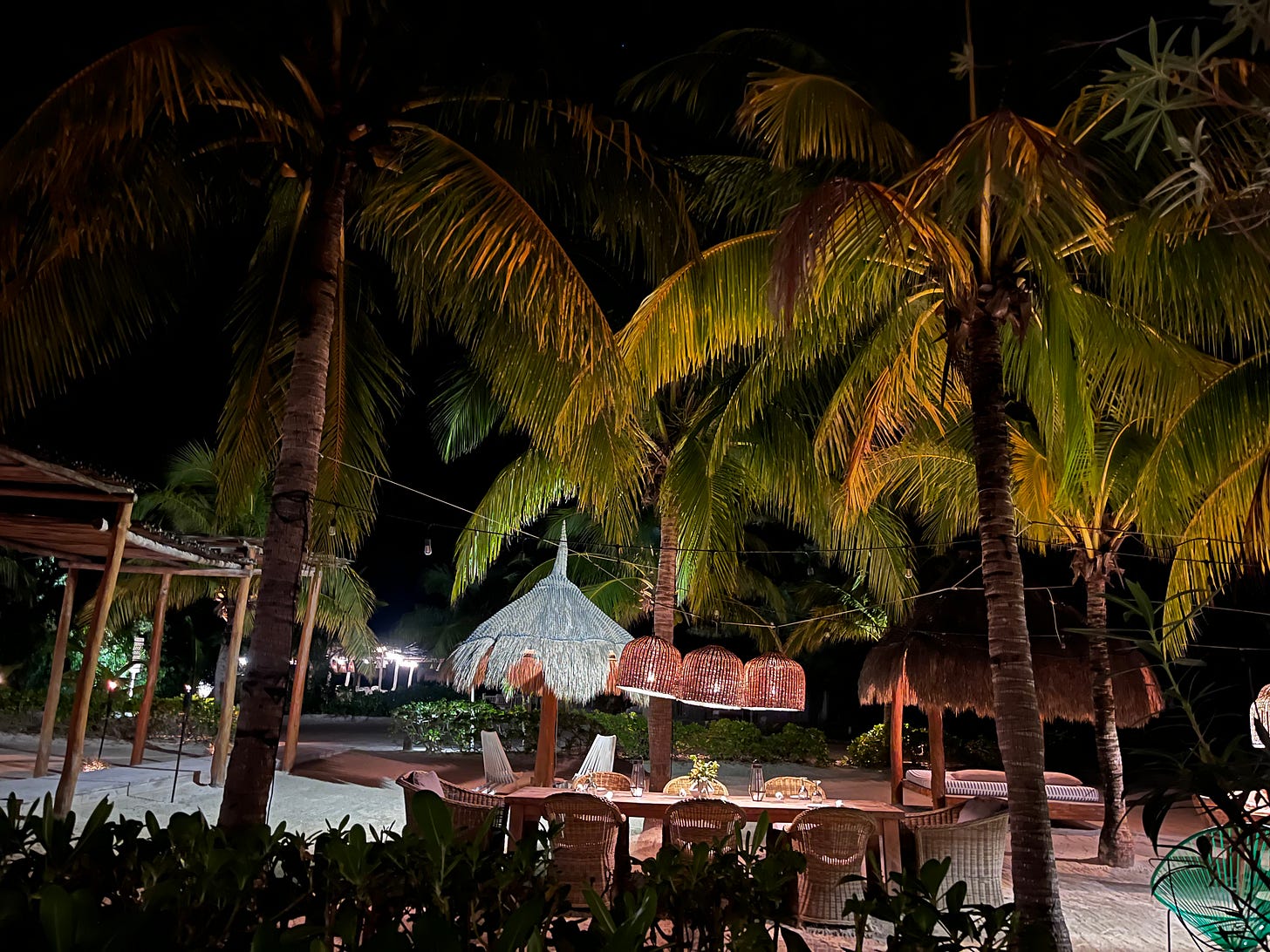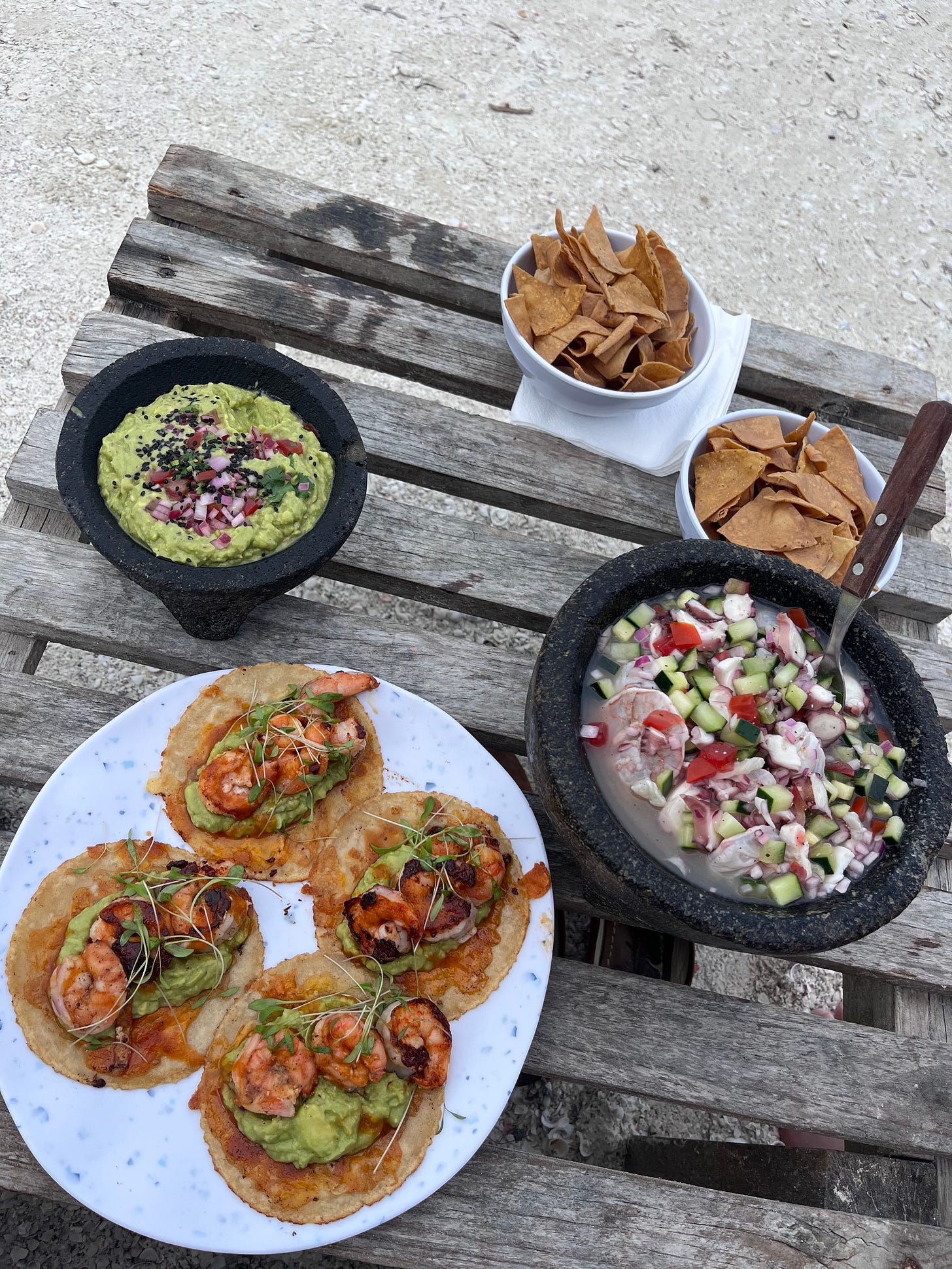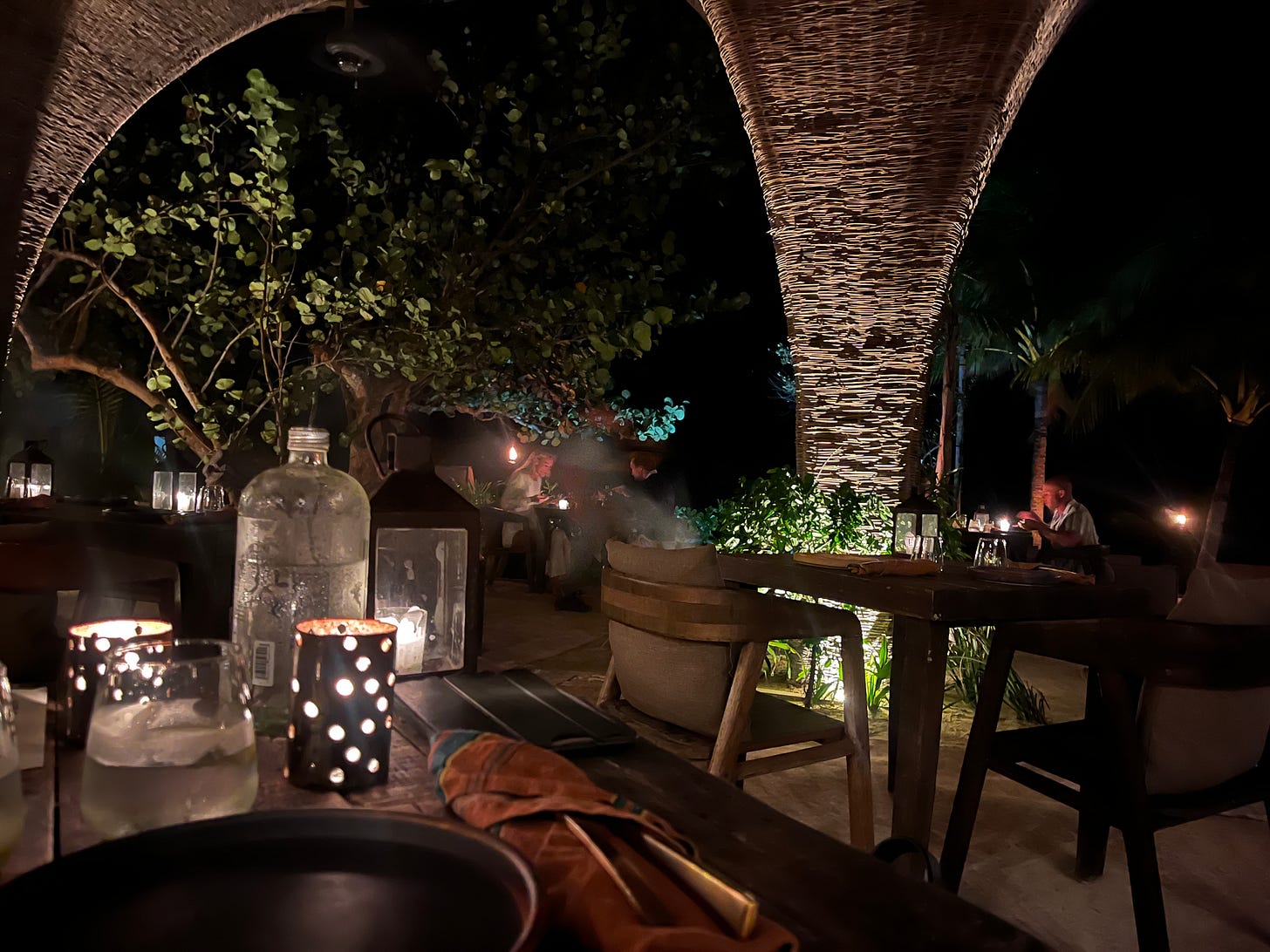Isla Holbox is a burst of sand in the Caribbean Sea just off the Yucatan Peninsula, 2.5 hours by land from Cancun, dotted with boutique hotels and burgeoning flora and fauna. If you blink you’ll miss it, and you’ll have missed out on heaven.
The morning hours are ethereal: at 7:30 AM, you walk barefoot from your hotel to the beach, stepping onto cooling, soft white sand and looking out into the blue-green horizon, stretching out endlessly like a Rothko painting laid horizontal. Wade into the warm and shockingly shallow ocean, and look admire the tiny tropical fish zipping around in their watery home. The beach is silent, save for the white ibis wading into the water next to you and the herons swirling above.
If you’re reading this, I implore you to hold Isla Holbox’s existence close to your chest (a nicer way to say, please gatekeep). So far, the island has been mostly sheltered from Tulum’s rapid development and Playa del Carmen and Cancun’s touristy chaos, but word is getting out.
The island is car-free and maybe the most relaxed place in the world. Towards the end, I wasn’t ever wearing shoes. Being there tempts you to throw your phone into the ocean; I did the next best thing and left it in a drawer in our hotel room all day. Much of Isla Holbox’s specialness comes from its feel of ephemerality: it feels like a place like this shouldn’t exist in 2025, and the threat of both climate change and corporate greed loom. The island cannot physically handle the sorts of large developments that are commonplace elsewhere on the Yucatan, and it feels like one bad storm could wipe the place out. I’ve never felt so blissfully disconnected with everything that doesn’t matter and connected with everything that does.
Holbox Guide:
Getting there:
TLDR: Cancun airport —> travel by land to Chiquila port —> Ferry from Chiquila port to Isla Holbox
Arduous, but worth it. Fly into Cancun airport, and from there you can travel by land or plane to Chiquila port, from which you’ll take the ferry to the island. Here’s how to get to Chiquila port, from most to least expensive:
If you have the funds, you can take a jet from Cancun airport to Holbox. The flight is ~30 minutes and you have to hire the entire plane vs. buy a seat on a commercial flight.
Hire a private car: most hotels on Holbox can arrange airport pickup for you. Est. time 2.5 hours.
Book seats on a shared shuttle (this is what we did and what I recommend). There were maybe 10 people in the van total, and the experience was pleasant and air conditioned. Est. time 2.5 hours.
Take the ADO bus from Cancun airport to the city of Cancun, then transfer to the ADO bus to Chiquila port. Est. time 4 hours.
Once you make it to Chiquila port, there’s ferries every 30 minutes and you can buy tickets at the port - no need to pre-book. The ferry takes 25-30 minutes to get to the island.
I would not recommend renting a car - you can’t take it to Holbox anyway.
Once you make it to the island you can catch a “cab” (aka a yellow golf cart) to your hotel.
Where to stay:
Punta Caliza (where we stayed)
One of the most beautiful, familial hotel experiences I’ve had. Punta Caliza (“limestone point” is a whitewashed, twelve-room boutique hotel tucked away from the busier hotel area and is a 5 minute walk to the beach. Its architectural language is muted, natural and geometric at the same time. As opposed to the sprawling outwardness of most beach hotels, Punta Caliza faces inward, onto a beautiful pool that runs through the hotel, allowing guests to swim to their rooms after a mezcalita.
The hotel is owned and run by a family from Tabasco; the father always wanted to own a home on Holbox. The daughter studied architecture and asked her professors to submit plans for the hotel: the result was twelve A-frame cabins done entirely in Mexican red cedar wood, at once rustic and airy.
The included breakfast is the culinary highlight - each morning, the chef offers a Mexican specialty like frijoles, chilaquiles, or avocado toast with local vegetables, plus fresh squeezed aguafrescas. By day 2, the staff know your breakfast likes and dislikes, and your coffee order. What Punta Caliza really offers is the feeling of being an insider - we mentioned we wanted to get massages and kayak, and the concierge hooked us up with “the best girls for that” and the “best guy for that”… seamless, hands free for us.
Note that they don’t allow kids.
If Punta Caliza is for young, cosmopolitan couples, Ser Casasandra is for young, cosmopolitan families or chic childless older couples. Conceived by artist and writer Sandra Perez, it is a colorful, boho design-forward 20-room beachfront hotel with a great beach club.
If Holbox isn’t enough of an escape for you, go to Nomade. We stayed at the one in Tulum and Nomade hotels are fantastic at ensconcing you in absolute bliss. Nomade Holbox is tucked away on the far western side of the island, only reachable by golf cart vs. the long beach road that connects the other hotels on the island. The food and programming are great; what Nomade really offers you is a chance to completely forget where you are and what year it is.
Casa Las Tortugas is a family-run beach hotel that is less design-y and more classic luxury than the aforementioned hotels, and is a good option if you want to stay closer to the heart of Holbox + the busier part of the beach. This hotel has what I think is the best beach club on the island - luxe day beds, great food, bonfires at night.
What to do:
Take a kayak tour through the mangroves. Much of Holbox is comprised of Yum Balam Nature Reserve, a protected area comprised of lagoons, mangroves and dunes that are home to thousands of threatened species. We explored this balmy raw nature via a sunrise kayak tour through the mangroves, where we saw ibises, egrets, stingrays, puffer fish, and crocodiles (no flamingoes because it was January). The experience of being out there as the sun rose was sublime. I believe I linked to the Turquesa Azul tour - if you can get Dali as your tour guide do it. He is a true environmentalist and possesses an amazing wealth of knowledge about Holbox’s ecology and its efforts to be more sustainable.
See the bioluminescence. We unfortunately came at the wrong time of year for this, but June through August is prime time for seeing this natural oceanic light show of glowing plankton.
Swim with whale sharks. Yum Balam is sanctuary for the highest concentration of whale sharks on the planet (May-Sept).
Walk along the sandbar to Punta Mosquito. The most special part of Holbox is the sandbar, which, at low tide, means many little islands are created amidst extremely shallow water. Starting in the morning, people begin the ~1-3 mile (depending where you start) walk along the sandbar out to Punta Mosquito, the opening to Yum Balam nature reserve and the most wild, untouched part of the beach stretch. Camp out for a few hours, but make sure to walk back before the tide gets too high.
Massages, spa treatments. The spas at Casa Las Tortugas, Ser Casasandra, and Hotel Las Nubes are said to be very nice. Punta Caliza set us up with masseuses in their open-air tower.
Beach clubs. You really can do Holbox by beach-club hopping every day if that’s your thing: standouts were Mojito (Ser Casasandra’s beach club), Mandarina (Casa Las Tortugas), and NANA. I also really liked the Punta Caliza beach club - it’s simpler than the aforementioned but has incredible food and is on a quieter part of the beach.
Where to eat:
Santos Fuegos
I want to start by saying that Santos Fuegos was the best meal on the island, and top 10 of my life! If you’ve been to Hartwood in Tulum, the concept is similar: the freshest island ingredients roasted or grilled over a giant open flame, outside. The restaurant is in the woods of the far western side of the island, and completely open air. The food is what I’d call jungle-Caribbean: Jicama salad with basil, citrus, and pumpkin seeds, Roasted carrots with a brown butter glaze, Sea bass crudo with chili oil and avocado, a roast whole chicken with zesty herbs, skirt steak with chimichurri, and my dream dessert: raw chocolate ganache with passionfruit puree. All washed down with Mexican white wine.
Two things to note: 1. This is maybe the only restaurant on the island where you need a reservation and 2. You’ll need to get there by golf cart taxi.
Ser Esencia
Hotel Ser Casasandra’s restaurant, and IMO the most elevated restaurant on the island food-wise. Like Places des Fetes’ bohemian cousin. Excellent service, and Yucatan dishes made luxury: ribeye glazed with orange and paint palettes of cauliflower puree, pork belly cubes with pineapple squares situated in basil sauce, caesar salad with black ash, and homemade guava cheesecake with guava ice cream.
La Barracuda
Locals spot recommended by Dali, our kayaking guide. As the name suggests, all simple seafood dishes, mostly pan fried or battered. The standout is the COCONUT SHRIMP: plump shrimp battered to hell with fresh coconut shreds and served with a coconut cream dipping sauce. The perfect afternoon snack.
LUUMA
This restaurant, part of Casa Las Tortugas, is very Tulum, with excellent cocktails, a fun atmosphere, and staffed by EIHGs. They serve tapas that are bursting with flavor - lamb kofta, pistachio coconut shrimp, stewed beef cheek with plantains. The mains are less exciting. I’d make a meal here entirely out of cocktails and appetizers.
La Popular (Nomade Temple)
Nomade could get away with having mid food, but its food is excellent. Retreat to Nomade’s restaurant, La Popular, for a long and lazy dinner away from the rest of the island under a thatched roof that feels religious. Our meal consisted of cocktails, Mexican red wine, prawns, a fresh tomato salad with tahini, and an outstanding ribeye.
Punta Caliza
While breakfast is the star, Punta Caliza does have a dinner menu consisting of warming classics, like sopa de limon (chicken soup with tortilla strips) and the catch of the day with coconut rice. Come here for a quiet, very personal and laid-back dinner on the patio.
outfit postscript:







